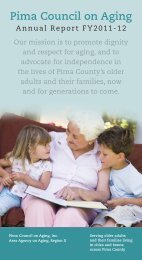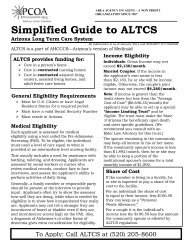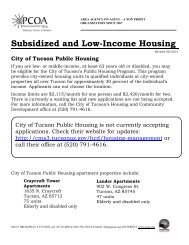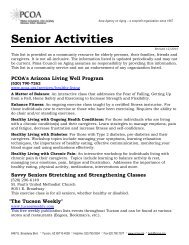view the brochure! - Pima Council On Aging
view the brochure! - Pima Council On Aging
view the brochure! - Pima Council On Aging
Create successful ePaper yourself
Turn your PDF publications into a flip-book with our unique Google optimized e-Paper software.
PART III<br />
PUBLIC NEEDS ASSESSMENT PROCESS<br />
The Area Plan on <strong>Aging</strong> Public Needs Assessment Process began in our community in 1975,<br />
and has been updated in three-year cycles to culminate in this most recent effort. In <strong>the</strong> 2012-<br />
2013 planning cycle, <strong>the</strong> community needs assessment and issue identification process was a<br />
collaborative venture of <strong>the</strong> City of Tucson, <strong>Pima</strong> County, Town of Marana, Town of Oro<br />
Valley, Town of Sahuarita, City of South Tucson, Greater Green Valley Community<br />
Foundation, United Way of Tucson and Sou<strong>the</strong>rn Arizona, Community Foundation for<br />
Sou<strong>the</strong>rn Arizona, Women’s Foundation of Sou<strong>the</strong>rn Arizona, Direct Center for Independence<br />
and <strong>the</strong> U of A Center on <strong>Aging</strong>. These are local funders with major planning responsibilities<br />
for human and social services in <strong>Pima</strong> County. The “Report to <strong>the</strong> Community on <strong>Aging</strong><br />
Services” (See Appendix 6) identifies <strong>the</strong> changing nature of our area’s senior population,<br />
anticipates future trends, identifies advocacy issues, best practices, successful programs that<br />
already meet <strong>the</strong> needs of local seniors and summarizes comments received as part of <strong>the</strong><br />
needs assessment process.<br />
Data was collected over a three-month period using a three-pronged approach proven<br />
effective in past years. Input was obtained from:<br />
focus groups of professionals working and providing services in <strong>the</strong> field of gerontology;<br />
2,330 survey responses tabulated through Survey Monkey from individuals 60 years of<br />
age or older, including homebound, senior club and organization members, service<br />
recipients and readers of “Never Too Late”, and<br />
ten public comment meetings held throughout <strong>the</strong> county, with Spanish language<br />
interpreters, including Tucson, Green Valley, Sahuarita, Marana, Tucson Estates and<br />
Oro Valley<br />
First, representatives from health and social service providers were invited to participate in<br />
focus groups held at various locations in <strong>Pima</strong> County during <strong>the</strong> month of October, 2012. The<br />
questions to be discussed were sent to participants in advance of <strong>the</strong> focus groups.<br />
Individuals not able to participate in <strong>the</strong> discussions were invited to complete <strong>the</strong> questionnaire<br />
in writing and return it for inclusion in <strong>the</strong> final report. Thirty (30) agencies provided written<br />
and/or verbal responses.<br />
The second method for identifying problem areas for older Americans was <strong>the</strong> distribution of<br />
surveys, printed in both English and Spanish. The survey was available for completion on<br />
Survey Monkey; included in a publication of PCOA’s “Never Too Late newsletter” and<br />
distributed to congregate and home delivered meal participants, members of numerous senior<br />
clubs and organizations, service recipients of various social service agencies and through faith<br />
communities and neighborhood associations. 2,330 surveys were received and tabulated with<br />
responses coming from all geographical areas of <strong>the</strong> County.<br />
Third, service needs, concerns and advocacy issues were identified at ten public comment<br />
meetings held in various locations throughout Tucson, Green Valley, Marana, Sahuarita,<br />
Tucson Estates and Oro Valley. At each meeting, a panel of Agency staff, a member of<br />
PCOA’s Board of Directors, Chairperson of <strong>the</strong> Area Agency on <strong>Aging</strong> Advisory <strong>Council</strong>, and<br />
representatives from <strong>the</strong> collaborative partners were present to listen and respond to advocacy<br />
issues, identification of individual service needs and proposed changes that should be made to<br />
existing services. Notice of <strong>the</strong>se meetings was sent to newspapers and radio stations, an<br />
article was published in “Never Too Late” and <strong>the</strong> information was distributed to senior clubs,<br />
organizations, centers and service providers in <strong>the</strong> area. Over one hundred and fifty-six (156)<br />
individuals attended and shared <strong>the</strong>ir comments and concerns.







